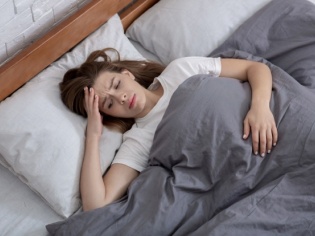-
Rohan Parekh
15th Nov 2021
Everyone lives with the fear that our smartphones are constantly spying on us and tracking our every move. But with the app, TapCounter, there is a new level of surveillance you can get for your phone. The app records each time you touch your phone’s screen. For an average person, it could end up reaching a count of almost 1000, if not more. But with work deadlines and errands to run, one tends to forgo the need to check social media as often. QuantActions is the European company behind the app and claims that they plan to detect and analyse the factors affecting users’ mental and neurological health with this data.
The company’s founder, Arko Ghosh, is a neuroscientist at Leiden University, Netherlands. He says that ‘tappigraphy patterns’ can analyse your sleep habits and your mental performance levels, and he has published data to support his statements.
The company has planned the launch of certain features based on these insights. However, Ghosh primarily wishes to use this data for medical reasons, such as predicting seizures in epileptic persons with the power of technology. In 2021, he published a clinical study of people with epilepsy, wherein he showed that even subtle changes in smartphone topography could be used to detect abnormalities in brainwaves.
His work and the app are part of a relatively new and rapidly developing field of digital phenotyping. It takes enormous quantities of raw data continuously collected from people’s smartphone use, wearables, and other digitals, analyses them using AI, and the infers behaviours related to health and disease.
Suppose digital biomarkers that are symptom-related digital signals can be appropriately applied to the field. In that case, it could provide a breakthrough in monitoring and diagnosing various medical conditions, especially those affecting mental and brain health. These could include episodes of depression, relapses in schizophrenia, mania in bipolar disorder, and many more. Even how toddlers gaze at the smartphone screen can be used to detect autism.
The data can be obtained from smartphone activity logs, measurements from built-in sensors like GPS, accelerometer, light sensors, and even user-generated content such as words and phrases. Brit Davidson, assistant professor of analytics at the University of Bath, UK, often described this method as repurposing data for secondary purposes rather than primary use.
This technology has been successful in capturing several tech giants’ interests. In September, several sources reported that Apple is working on specific features that can help diagnose depression and cognitive decline. Google has also shown its interest. Apple most likely wishes to correlate and combine its existing features with its new launches to establish mental health disorders. This statement has been backed by Helen Christensen, professor of mental health at the University of New South Wales in Australia, the Black Dog Institute leader, a nonprofit organisation focused on the diagnosis, treatment, and prevention of mood disorders.
Meanwhile, several health and wellness startups in Silicon Valley have already started incorporating similar technology in their products, although they do not include a clinical diagnosis. One such company is Mindstrong, which virtually provides therapy and psychiatry services and has received hefty funding, even from Jeff Bezos’ venture capital firm. The company claims to use patented technology to track the tap, scroll, and click of clients on their phones so that clinicians can provide a personalised and integrative solution. Ginger also offers on-demand mental health support, although their digital phenotyping algorithm is rather rudimentary. They do so by analysing the text conversation between users and coaches to provide a diagnosis. Nicole Martinez-Martin, a bioethicist at Stanford University in California, is worried about the transparency of exactly how these companies function.
Conventionally, mental illness has been diagnosed in a clinical setting based on self-reported experiences and medical assessment. However, this form of diagnosis can be highly subjective. Digital phenotyping, on the other hand, provides the opportunity to study and collect data on a person’s behavioral patterns in continuity. Jukka-Pekka Onnela, a biostatistician at Harvard University, Massachusetts, who has played a significant role in pioneering digital phenotyping with several ongoing projects, believes that this method could provide a much more accurate way of diagnosing people.
Considering the increased incidence of mental health problems and the subsequent shortage of resources, it could also provide a cheaper, quicker, and more efficient method. It will allow people to manage their mental health better and could prove to be a significant breakthrough in mental health and disease.
Cogito Companion has skillfully illustrated how they may use the technology in the future. It is an experimental decision support tool used by clinicians to diagnose mood and anxiety disorders. After receiving its funding from the Pentagon’s research agency, the Defense Advanced Research Projects Agency (Darpa), the Boston-based startup is working towards using it medically for veterans and military personnel. It is currently under clinical trial among 750 sailors returning from overseas deployments.
The tool is installed as an app on the subject’s phone. It passively looks for sudden collapse in social interactions or indications of avoidance of activities by examining the text and call patterns and the mobility data. It also checks for signs of depression by analysing how participants speak in short voice diaries they must record. Nearly 200 different signals, ranging from energy to pauses and even intonation, are analysed to determine the overall risk score for that participant. Skyler Place, chief behavioural science officer at Cogito, adds that this data is then sent to the participant’s clinician for diagnosis.
Although this technology is up-and-coming, the questions of privacy and purpose pose significant challenges to its future.
Firstly, the technology requires more in-depth analysis to ensure that meaningful and reliable medical information can be derived. Although several academic studies have been published, they have only been small pilot studies with a minuscule subject count. For instance, Ghosh’s epilepsy study involved only eight subjects. Mindstrong’s data was derived from 27 participants. Christensen says that if these algorithms are to be used medically, they will need to involve more than several thousand participants. Furthermore, pilots are only recently giving way to more extensive studies. Cogito Companion’s current trial is a smaller proof-of-concept study.
Recent research has started including healthy people, compared to pilot studies that only include those with established clinical diagnoses. For example, the BiAffect research, run by the University of Illinois, Chicago, is focused on keystroke behaviour to predict bipolar episodes. It has an open science component, wherein the public can download an app and take part. This method allows better comparison between healthy and unhealthy individuals. The study has about 2000 participants currently.
Apple’s interest in smartphone diagnosis may have stemmed from the research collaboration with the University of California, Los Angeles (UCLA), and Biogen, the pharmaceutical giant. The two pairs aim to study the digital biomarkers of depression and anxiety and mild cognitive impairment, respectively. Both focus on gathering data from iPhones and Apple Watches used by participants and use this information for analysis and inference. The UCLA study started with just 150 participants in its pilot phase, but since then has diverged with the main phase tracking 3000 participants, including healthy individuals. The Biogen study began in September and planned to enroll 23000 participants, including the general population.
The most significant challenge researchers face in this field is the widespread data variability. Since people tend to use their phones very differently, it isn’t easy to compare their behaviour, even amongst a large population. The connection between online and offline behaviour also tends to be ambiguous. Brit Davidson points out that a sudden drop in smartphone activity could be a sign of withdrawal, but it could also simply mean increased offline communication and activity.
Algorithms are not spared from potential bias, which is well-documented in other AI-based technology. This bias indicates that certain groups could be affected negatively by the technology and may not benefit from it. For example, most health-related research tends to opt for white, more affluent, and educated populations, and data transfer is a big concern, says Stanford’s Martinez-Martin.
Privacy is also a big issue. While academic research studies follow strict protocols, private companies tend not to follow the same level of discipline regarding privacy and confidentiality. Although companies can share data with predictive inferences made with digital phenotyping, it could have its impacts. Martinez-Martin believes that these inferences may benefit specific populations such as employers, insurers, and education providers, and they may misuse the data. Although the data is usually anonymous, it may also be reidentified just as quickly.
The protection under US law for sensitive health information generally applies to healthcare systems only and skips the tech companies. Digital phenotyping is unlikely to be included under the category and definition of sensitive health information. So the old data protection method does not apply much to the new digitalised world, says Martinez-Martin.
One cannot dismiss the possibility of digital phenotyping competing with doctors altogether.
What if the algorithm’s assessment is more objective than a doctor’s? What if the tool’s opinions differ from that of the physician? Although technology does have potential in mental health services, Rosie Weatherley, information content manager at the mental health charity Mind, believes that human interaction and professional clinical diagnosis are irreplaceable and must remain the predominant method of diagnosing, treating, and supporting a patient’s experiences.
Lisa Cosgrove, professor of counselling psychology at the University of Massachusetts, Boston, studies social justice issues in psychiatry and raises a more philosophical point. Digital phenotyping tends to focus intensely on the individual, deviating from the root socio-political causes such as job loss, eviction, and discrimination. Of course, individual care is essential, but digital phenotyping excludes the most common context in which people experience emotional distress, she says.
Ghosh remains hopeful that the technology can be beneficial to society. However, since this form of data and its study is a new aspect of research, they demand time and effort for better understanding. Ghosh hopes to make sure they are helping people instead of disturbing their lives.
mental health apps, mental health awareness, Mental Health Disorders, TapCounter, Tappigraphy
How many mental health disorders are caused by your phone? | TechTree.com
How many mental health disorders are caused by your phone?
Is the number of times you tap your phone linked to Mental Health Disorders?
News Corner
- DRIFE Begins Operations in Namma Bengaluru
- Sevenaire launches ‘NEPTUNE’ – 24W Portable Speaker with RGB LED Lights
- Inbase launches ‘Urban Q1 Pro’ TWS Earbuds with Smart Touch control in India
- Airtel announces Rs 6000 cashback on purchase of smartphones from leading brands
- 78% of Indians are saving to spend during the festive season and 72% will splurge on gadgets & electronics
- 5 Tips For Buying A TV This Festive Season
- Facebook launches its largest creator education program in India
- 5 educational tech toys for young and aspiring engineers
- Mid-range smartphones emerge as customer favourites this festive season, reveals Amazon survey
- COLORFUL Launches Onebot M24A1 AIO PC for Professionals







TECHTREE